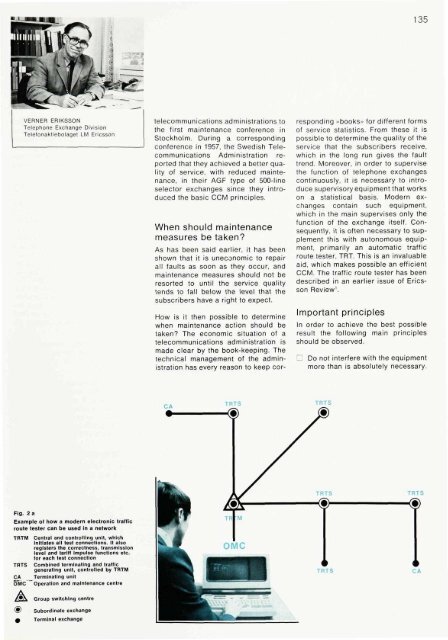geostationary telecommunications satellites electronic telephone set ...
geostationary telecommunications satellites electronic telephone set ...
geostationary telecommunications satellites electronic telephone set ...
Create successful ePaper yourself
Turn your PDF publications into a flip-book with our unique Google optimized e-Paper software.
135<br />
VERNER ERIKSSON<br />
Telephone Exchange Division<br />
Telefonaktiebolaget LM Ericsson<br />
<strong>telecommunications</strong> administrations to<br />
the first maintenance conference in<br />
Stockholm. During a corresponding<br />
conference in 1957, the Swedish Telecommunications<br />
Administration reported<br />
that they achieved a better quality<br />
of service, with reduced maintenance,<br />
in their AGF type of 500-line<br />
selector exchanges since they introduced<br />
the basic CCM principles.<br />
When should maintenance<br />
measures be taken<br />
As has been said earlier, it has been<br />
shown that it is uneconomic to repair<br />
all faults as soon as they occur, and<br />
maintenance measures should not be<br />
resorted to until the service quality<br />
tends to fall below the level that the<br />
subscribers have a right to expect.<br />
How is it then possible to determine<br />
when maintenance action should be<br />
taken The economic situation of a<br />
<strong>telecommunications</strong> administration is<br />
made clear by the book-keeping. The<br />
technical management of the administration<br />
has every reason to keep corresponding<br />
»books» for different forms<br />
of service statistics. From these it is<br />
possible to determine the quality of the<br />
service that the subscribers receive,<br />
which in the long run gives the fault<br />
trend. Moreover, in order to supervise<br />
the function of <strong>telephone</strong> exchanges<br />
continuously, it is necessary to introduce<br />
supervisory equipment that works<br />
on a statistical basis. Modern exchanges<br />
contain such equipment,<br />
which in the main supervises only the<br />
function of the exchange itself. Consequently,<br />
it is often necessary to supplement<br />
this with autonomous equipment,<br />
primarily an automatic traffic<br />
route tester, TRT. This is an invaluable<br />
aid, which makes possible an efficient<br />
CCM. The traffic route tester has been<br />
described in an earlier issue of Ericsson<br />
Review 1 .<br />
Important principles<br />
In order to achieve the best possible<br />
result the following main principles<br />
should be observed.<br />
IZ Do not interfere with the equipment<br />
more than is absolutely necessary.<br />
Fig. 2 a<br />
Example of how a modern <strong>electronic</strong> traffic<br />
route tester can be used in a network<br />
TRTM Central and controlling unit, which<br />
Initiates all test connections. It also<br />
registers the correctness, transmission<br />
level and tariff Impulse functions etc.<br />
for each test connection<br />
TRTS Combined terminating and traffic<br />
generating unit, controlled by TRTM<br />
CA Terminating unit<br />
OMC "Operation and maintenance centre<br />
Group switching centre<br />
® Subordinate exchange<br />
9 Terminal exchange
















